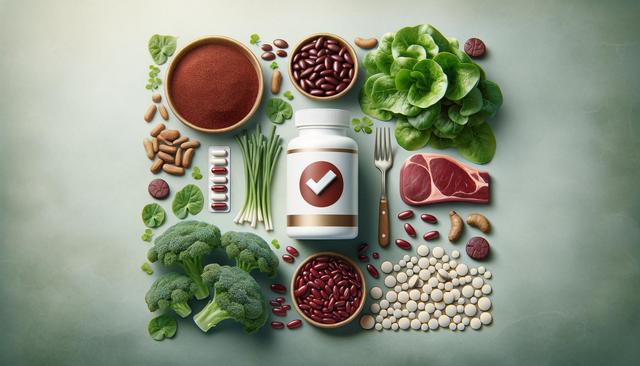Understanding Iron Deficiency and Its Effects
Iron deficiency is one of the most common nutritional deficiencies worldwide, and it can have a significant impact on your daily life. Iron is essential for producing hemoglobin, a protein in red blood cells that carries oxygen throughout your body. When your iron levels are low, your body struggles to get the oxygen it needs, leading to symptoms such as fatigue, dizziness, pale skin, and shortness of breath. In more serious cases, chronic iron deficiency can contribute to anemia, a condition that requires medical attention. Understanding the role of iron in the body is the first step in addressing deficiency through both dietary and lifestyle changes. While supplements are sometimes necessary, food-based solutions are a natural and sustainable way to support iron levels over time.
Top Iron-Rich Foods to Include in Your Diet
There are two types of iron found in food: heme iron and non-heme iron. Heme iron, found in animal-based sources, is more easily absorbed by the body, while non-heme iron comes from plant-based foods and requires a bit more strategy for effective absorption. Both types are important to include in your diet.
Here are some iron-rich foods worth adding to your meals:
- Red meat, poultry, and fish (heme iron)
- Spinach, kale, and other dark leafy greens (non-heme iron)
- Lentils, chickpeas, and beans (non-heme iron)
- Tofu and tempeh (non-heme iron)
- Iron-fortified cereals and grains
- Pumpkin seeds, sunflower seeds, and nuts
Incorporating a variety of these foods into your weekly menu can help support your iron levels naturally. Keep in mind that the iron content varies between foods, so a diverse mix can provide better overall benefits.
Boosting Iron Absorption with the Right Combinations
Eating iron-rich foods is only part of the solution. To make the most of the iron content in your meals, it’s essential to pair them with nutrients that enhance absorption. Vitamin C is particularly effective in helping your body absorb non-heme iron, which is found in plants.
Try the following combinations to improve iron uptake:
- Pair spinach or kale with citrus fruits like oranges or grapefruit
- Enjoy lentils with bell peppers or tomatoes
- Add strawberries or kiwi to your breakfast cereal
- Use lemon juice as a dressing for leafy green salads
On the other hand, some foods and drinks can inhibit iron absorption. These include coffee, tea, dairy products, and calcium supplements when consumed at the same time as iron-rich meals. To get the most benefit, consider spacing out these items from your main iron sources by at least an hour or two.
Simple Meal Ideas That Support Iron Intake
Planning iron-friendly meals doesn’t have to be complicated. With a few tweaks, it’s easy to create dishes that naturally support your body’s iron needs. Here are some simple ideas to get started:
- Grilled chicken salad with spinach, orange slices, and a lemon vinaigrette
- Stir-fried tofu with broccoli, bell peppers, and brown rice
- Lentil soup with tomatoes and a side of whole-grain bread
- Beef or turkey chili with kidney beans and chopped tomatoes
- Oatmeal topped with pumpkin seeds and fresh strawberries
By making small adjustments to your usual recipes—like swapping out lettuce for spinach or adding a squeeze of lemon—you can increase the iron content of your meals with minimal effort. Preparing meals at home also gives you more control over ingredients and portion sizes, ensuring you’re getting a balanced intake of iron-rich foods.
When to Consider Supplements and Medical Advice
While dietary changes can make a significant difference, there are situations where supplements or medical treatment might be necessary. Individuals with chronic iron deficiency anemia, heavy menstrual cycles, gastrointestinal issues, or those following a strict vegetarian or vegan diet may need additional support. If you suspect you have low iron levels, it’s important to consult a healthcare provider for proper diagnosis and treatment.
Common signs that may indicate the need for professional evaluation include:
- Unexplained fatigue or weakness
- Frequent headaches or dizziness
- Cold hands and feet
- Craving non-food items like ice, dirt, or starch (a condition called pica)
A blood test can determine iron levels and help guide the appropriate course of action. If supplements are recommended, they should be taken as directed, since excessive iron intake can cause side effects and may be harmful in large doses.
Conclusion: Supporting Your Body Naturally Through Diet
Iron deficiency can affect your energy, focus, and overall well-being, but with the right dietary strategies, it’s possible to restore balance naturally. By including a diverse selection of iron-rich foods, pairing them with vitamin C sources, and being mindful of absorption inhibitors, you can support your body’s needs effectively. For those who require additional help, medical guidance ensures that treatment is safe and appropriate. Focusing on whole food solutions not only helps correct iron deficiency but also encourages healthier eating habits overall.




Leave a Reply